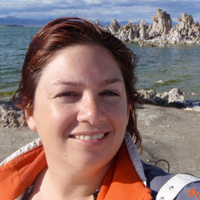 Heather O’BrienWater Chemistry in Two Multi-Depth Monitoring Wells in San Diego, California: A Comparison of Core Extracted Pore Water Versus Multiple Depth Well Samples Wednesday, May 11th, 2011 |
||
|
||
| ABSTRACT In 2001, the United States Geological Survey, in partnership with Sweetwater Authority and the City of San Diego, began a study to assess the geology and hydrology of the San Diego area. In addition to collecting surface water samples, seven multi-depth wells have been installed by USGS into the San Diego Formation and the overlying alluvial deposits to evaluate their potential as a resource for recharge and extraction. While multi-depth wells allow for groundwater quality at the screened depths, pore water analysis may provide a nearly continuous well profile, and help to identify stratigraphic constraints on the hydrology. Pore water was extracted from the drill cores of two USGS multi-depth wells, San Diego Sweetwater (SDSW) and San Diego Country Club (SDCC). This study compares the chemistry of the pore water and multi-depth well samples in each well to assess the value of running pore water analyses in future wells. Well and pore water samples at similar depth (+/- 5 ft) showed high accuracy in the data, except where the lithologic log showed variance. The comparison shows that, by additionally extracting pore water from the core, the pore samples are useful as an accuracy check. Also, because the chemical variance between some of the samples at similar depth coincided with a change of lithology, this shows that chemical analysis of pore water can also be used to pinpoint hydrologic boundaries and transitions. Lastly, the addition of so many more samples at specific depth gives us more values to interpret the sources influencing water quality. |

